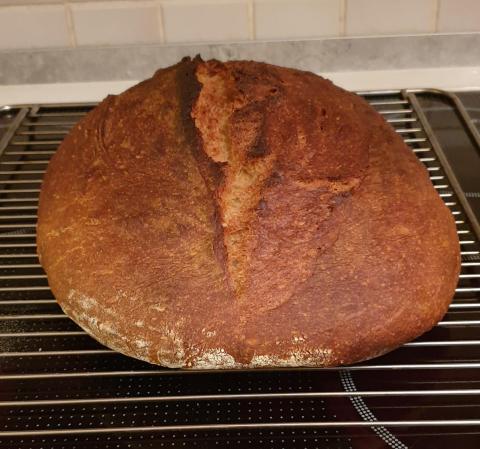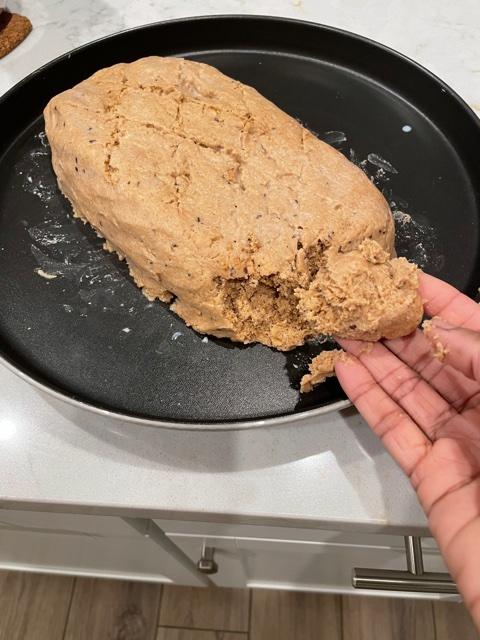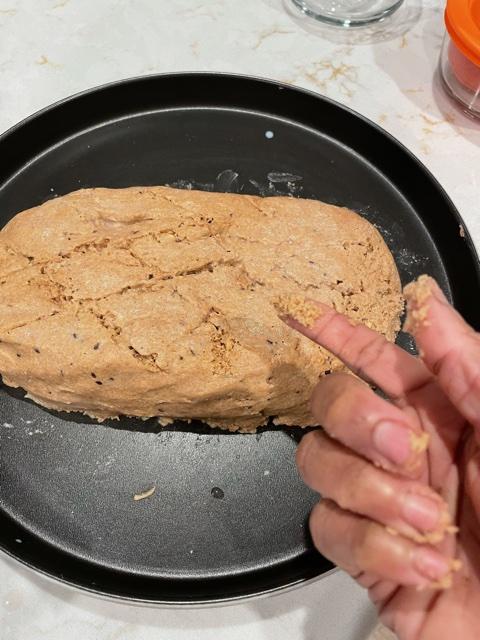It was time to revisit this one after taking a break for the holidays.
Recipe
Makes 3 loaves
150 g Spelt flour (~150 g Spelt berries)
150 g Kamut flour (~150 g Kamut berries)
50 g rye flour (~50 g Rye berries)
700 g strong bakers unbleached flour
725 g of filtered water
10 g Old Bay seasoning
15 g Pink Himalayan salt
30 g yogurt
250 g levain (procedure is in recipe and will need additional wholewheat flour and unbleached flour)
Add-ins
145 g of drained sliced mixed olives (50 g Kalamata, 50 g Manzanilla and 45 g Black)
130 g crumbled Feta
72 g Seasoned Sun-dried Tomatoes in oil, drained and 25g of oil reserved
The night before:
1. Mill the grains on the finest setting of your mill. Measure the Spelt, Kamut, and rye flours and place in a tub.
2. Add the unbleached flour to the milled flours and reserve.
3. Take 10 g of refrigerated starter and feed it 20 g of water and 20 g of wholegrain flour. Let that rise at cool room temperature for the night.
Dough making day:
1. Feed the levain 100 g of filtered water and 100 g of unbleached flour. Let rise in a warm place till double. This took about 5 hours.
2. Measure the feta, crumble if needed, and set aside.
3. Drain (save the oil) and weigh the sun-dried tomatoes, (slice if not sliced), measure out 25 g of the reserved oil, and add both to the feta.
4. Drain the olives, weigh, and add to the feta mix.
5. An hour or two before the levain is ready, mix the water with the flours and autolyse. This takes a minute or two in a mixer. Let autolyse until
the levain is ready.
6. Once the levain has doubled, add the Old Bay seasoning, the salt, the yogurt, the feta/olive/tomato mix, and the levain. Mix for a minute on low until the levain is integrated, then mix on speed 2 for 9 minutes.
7. Cover and let rest 45 minutes.
8. Do 2 sets of coil folds with 45 minute intervals and then 2 more set with 30 minute intervals. Let rise until you see lots of small irregular bubbles through the wall of your container. The dough should have risen about 30-40%.
9. Tip the dough out on a bare counter, sprinkle the top with flour and divide into portions of ~825 g. Round out the portions into rounds with a dough scraper and let rest 30 minutes on the counter.
10. Do a final shape by flouring the top of the rounds and flipping the rounds over on a lightly floured counter. Gently stretch the dough out into a circle. Pull and fold the third of the dough closest to you over the middle. Pull the right side and fold over the middle and do the same to the left. Fold the top end to the center patting out any cavities. Finally stretch the two top corners and fold over each other in the middle. Roll the bottom of the dough towards you until the seam is underneath the dough. Cup your hands around the dough and pull towards you, doing this on all sides of the dough to round it off. Finally spin the dough to make a nice tight boule.
11. Sprinkle rice flour in the bannetons. Place the dough seam side down in the bannetons, cover, let rest for a few minutes on the counter and then put to bed in a cold (38F) fridge overnight.
Baking Day
1. The next morning, heat the oven to 475F with the Dutch ovens inside for 45 minutes to an hour. Turn out the dough seam side up onto a cornmeal sprinkled counter. Place rounds of parchment paper in the bottom of the pots, and carefully place the dough seam side up inside.
2. Cover the pots and bake the loaves at 450 F for 25 minutes, remove the lids, and bake for another 22 minutes. Internal temperature should be 205 F or more.













 Hello ,
Hello ,








